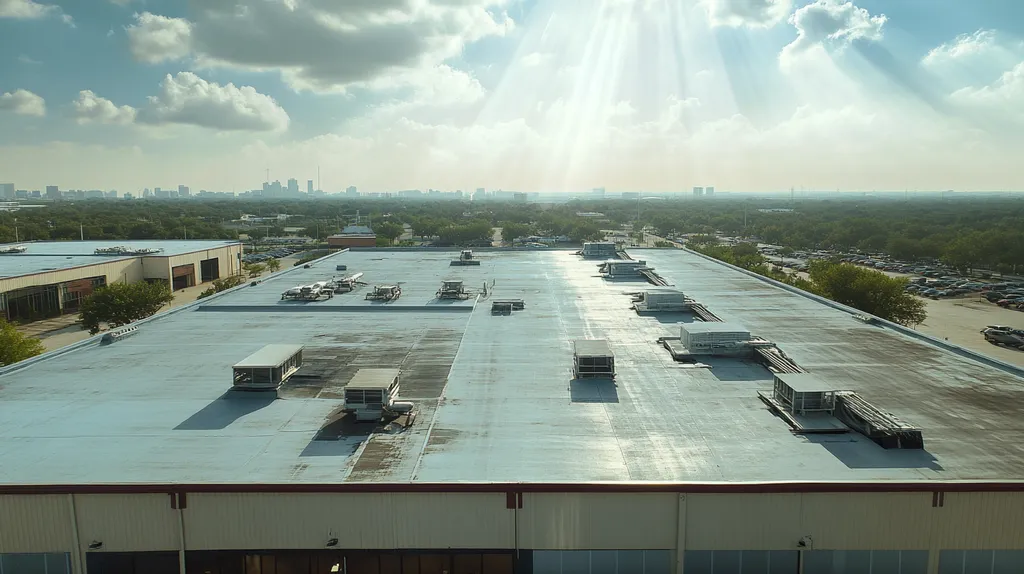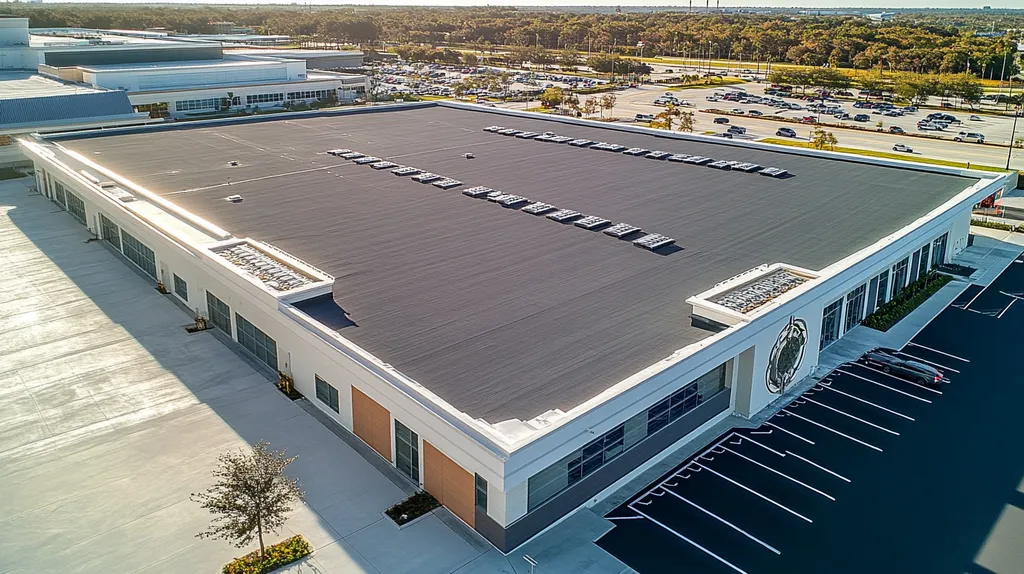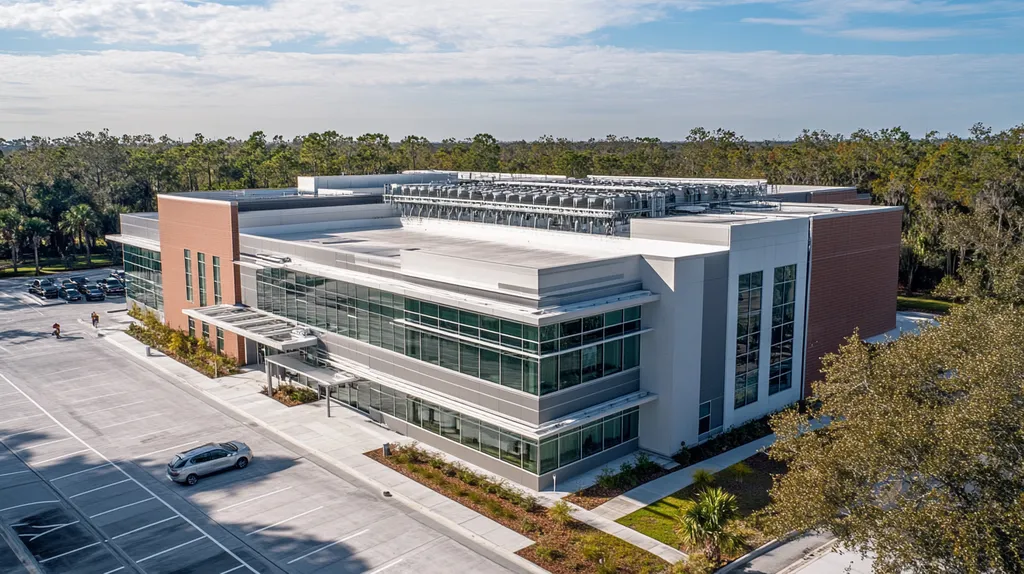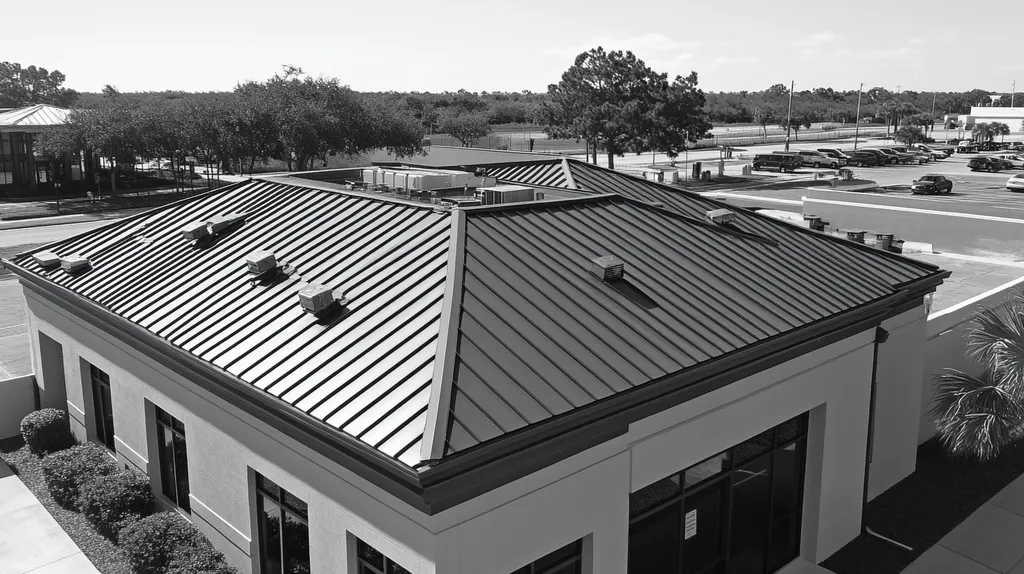In tourist destinations worldwide, commercial roofs face challenges that go far beyond typical wear and tear. Recent industry studies show these structures experience up to 300% more stress from foot traffic, equipment vibration, and environmental exposure compared to standard commercial buildings.
Yet many property owners continue to treat tourist-area roofs like standard commercial installations, leading to premature failures and costly emergency repairs that can devastate seasonal businesses.
From coastal resorts battling salt spray to mountain lodges managing snow loads, understanding the unique demands of tourist-area roofing has become crucial for protecting these valuable commercial investments.
SECTION 1: COMMON MISCONCEPTIONS
In the ever-evolving landscape of tourist destinations, commercial roofing has become increasingly critical. The stakes are particularly high, as roofs in these high-traffic areas face unique challenges that can significantly impact both safety and business operations. Recent industry data shows that roofs in tourist zones typically require maintenance 40% more frequently than those in standard commercial areas, yet many property owners continue to operate under outdated assumptions about roof management.
Ignoring Regular Inspections
The roof serves as a commercial building’s first line of defense against natural hazards including wind, rain, hail, ice, and snow. Regular inspections are essential for maintaining this crucial protective barrier. (source: Insurance Institute for Business & Home Safety)
Tourist areas present unique challenges, with increased foot traffic from maintenance workers accessing rooftop equipment and additional stress from vibrations caused by high visitor volumes. These factors accelerate wear and can create vulnerabilities that only regular inspections will reveal.
Many property owners mistakenly believe that new roofs require minimal attention. This mindset often leads to overlooked minor issues that eventually escalate into major structural problems.
Documentation from regular inspections proves invaluable for warranty claims and insurance purposes. Without this record, property owners may face denied claims and increased liability exposure.
Believing All Roofs Are Equal
The roofing industry has evolved significantly over the past decades, yet many continue to view commercial roofs as uniform systems. This oversimplification ignores crucial differences in materials, design, and performance characteristics.
Tourist-area buildings often require specialized roofing solutions that can withstand increased exposure to environmental stressors. Different roof types offer varying levels of durability, energy efficiency, and weather resistance.
The aesthetic impact of roofing choices carries particular weight in tourist districts. An inappropriate roofing system can detract from a building’s architectural character and negatively impact the overall appeal of the area.
Modern roofing materials offer advanced features like enhanced UV protection and improved insulation properties. These innovations become particularly relevant in high-visibility tourist locations where appearance and performance must align.
Overlooking Local Climate Factors
Each tourist destination presents its own set of environmental challenges. Coastal areas face salt spray and high humidity, while mountain regions contend with snow loads and extreme temperature variations.
Property owners often underestimate how local weather patterns affect roofing performance. A system that excels in one climate may fail prematurely when installed in a different environment.
Seasonal tourist patterns can amplify climate-related stresses on roofing systems. Peak visitor seasons often coincide with extreme weather conditions, creating additional strain on roofing materials.
Understanding local climate factors helps inform maintenance schedules and material choices. This knowledge proves essential for developing effective long-term roofing strategies that protect tourist-area investments.
SECTION 2: PRACTICAL IMPLICATIONS
In tourist destinations, where commercial buildings face extraordinary demands, roofing decisions carry far-reaching consequences. The evolution from traditional built-up roofs to modern synthetic systems mirrors the increasing complexity of these challenges. Recent data indicates that tourist-area commercial roofs experience up to 300% more foot traffic than standard commercial buildings, while facing heightened exposure to environmental stressors and seasonal weather extremes.
Impact on Roof Lifespan
The roof is a commercial building’s first line of defense from natural hazards such as wind, rain, hail, ice, and snow, making its longevity crucial in tourist areas. Regular inspections and maintenance become essential to extending roof lifespan and preventing premature failure. (source: Insurance Institute for Business & Home Safety)
Tourist destinations often subject roofs to extreme temperature fluctuations and increased UV exposure. These conditions can accelerate material degradation, particularly in traditional single-ply membranes that weren’t designed for such intensive exposure.
Coastal locations present additional challenges through salt spray and high humidity. These elements can reduce a standard commercial roof’s lifespan by 30-40% if not properly addressed through specialized materials and enhanced maintenance protocols.
Modern synthetic roofing systems, when properly specified for tourist area applications, can extend service life by up to 25 years. This longevity depends on choosing materials tested specifically for high-traffic and extreme weather conditions.
Effects on Energy Efficiency
Tourist area buildings typically operate at peak capacity during extreme weather seasons, magnifying the impact of roofing choices on energy consumption. Poor insulation or deteriorating roof systems can increase cooling costs by up to 40% during peak tourist months.
Contemporary cool roofing technologies can reduce surface temperatures by as much as 60°F compared to traditional dark membranes. This temperature reduction translates to significant energy savings and improved indoor comfort for visitors.
Reflective coatings and advanced insulation systems have revolutionized energy management in tourist-area buildings. These innovations can reduce HVAC loads by 15-25%, offering substantial operational cost savings.
The integration of solar-reflective materials with proper ventilation systems creates synergistic benefits. This combination optimizes energy efficiency while extending roof life through reduced thermal stress.
Consequences for Building Integrity
Structural integrity in tourist-area buildings depends heavily on roof performance. Water infiltration from compromised roofing can lead to extensive damage, potentially affecting guest areas and causing business interruptions.
High-traffic tourist zones require roofing systems capable of handling increased mechanical stress. The weight and vibration from rooftop equipment, combined with frequent maintenance access, can accelerate wear patterns.
Modern building codes in tourist areas often mandate higher performance standards for roofing systems. These requirements reflect the increased risks associated with public occupancy and the need for enhanced durability.
Proper drainage design becomes critical in tourist area applications. Even minor ponding issues can escalate quickly due to increased debris accumulation from heightened environmental exposure.
SECTION 3: COST OF MISINFORMATION
The financial impact of roofing misinformation in tourist areas extends far beyond simple repair costs. Modern commercial properties face unprecedented challenges, from increased rooftop amenities to extreme weather patterns. Analysis shows property owners who rely on outdated roofing information typically spend 40% more on emergency repairs and face up to 25% higher insurance premiums. Understanding the true cost of misinformation has become critical as tourist properties evolve from simple structures to complex entertainment destinations.
Financial Burden of Neglect
When commercial property owners in tourist areas operate under misconceptions about roof maintenance, the financial consequences compound rapidly. What begins as minor neglect often cascades into major structural issues, requiring extensive repairs that can cost ten times more than preventive maintenance.
Tourism properties face unique challenges with rooftop equipment, outdoor seating areas, and entertainment spaces adding significant stress to roofing systems. These additional load factors require careful consideration during design and ongoing maintenance to prevent structural damage. (source: Buzon UK)
Insurance carriers increasingly scrutinize maintenance records when evaluating coverage for tourist-area properties. Buildings with documented maintenance gaps often face premium increases of 15-30%, directly impacting operational budgets.
The cost of neglect extends to energy efficiency, with poorly maintained roofs increasing cooling costs by up to 40% during peak tourist seasons. This inefficiency creates an ongoing drain on resources that could otherwise support property improvements.
Unexpected Repair Expenses
Tourist area properties frequently encounter sudden repair needs that catch owners off guard. These emergencies often stem from misconceptions about roof durability and maintenance requirements in high-traffic environments.
Weather-related damage poses a particular threat, as tourist season often coincides with extreme weather patterns. Properties operating under outdated assumptions about weather resistance face repair costs averaging 250% higher than those with properly specified systems.
The complexity of modern roofing systems means that repairs often require specialized knowledge and equipment. When owners delay maintenance based on incorrect information, simple fixes can escalate into complete system failures.
Emergency repairs during peak tourist seasons can cost up to four times more than scheduled maintenance. This premium reflects both the urgency of the work and the limited availability of qualified contractors during busy periods.
Loss of Property Value
Roofing misinformation directly impacts property valuations in tourist districts. Buildings with documented roofing issues typically see value decreases of 15-25%, with some facing even steeper declines in highly competitive markets.
Modern tourists increasingly value sustainable and well-maintained properties, making roof condition a critical factor in property marketability. Hotels and retail spaces with outdated or poorly maintained roofs often see booking rates drop by 20-30%.
The rise of rooftop amenities in tourist areas has elevated the importance of roof condition in property valuation. Buildings unable to support these features due to poor roof maintenance often struggle to compete in premium markets.
Commercial property buyers now routinely include detailed roof assessments in their due diligence process. Properties with histories of deferred maintenance or improper repairs often face significant value adjustments during sales negotiations.
SECTION 4: REALITY CHECK
The evolution of commercial roofing in tourist areas mirrors the transformation of these destinations themselves. Where simple tar and gravel systems once dominated the landscape, today’s roofs must withstand unprecedented challenges while supporting sophisticated amenities. Recent studies show that tourist-area commercial roofs experience failure rates three times higher than standard commercial installations when proper maintenance protocols aren’t followed, highlighting the critical need for a reality-based approach to roof management.
Importance of Bi-Annual Inspections
The days when annual inspections sufficed for commercial roofs have long passed, particularly in tourist zones where environmental stresses compound rapidly. Modern roofing systems, despite their advanced materials, require systematic evaluation twice yearly to maintain their protective capabilities.
Spring inspections help identify damage from winter weather patterns, while fall assessments ensure readiness for upcoming seasonal challenges. This systematic approach proves especially crucial in tourist areas where business disruptions carry exponential costs.
Proper structural metal panel roof systems require specific approvals to ensure adequate wind resistance and long-term performance in demanding tourist environments. (source: Insurance Institute for Business & Home Safety)
Documentation from these inspections creates a valuable performance history that supports warranty claims and helps predict maintenance needs. This historical record proves invaluable when planning renovations or evaluating system upgrades.
Role of Core Samples in Maintenance
Core sampling has emerged as an essential diagnostic tool, revealing hidden deterioration that visual inspections might miss. This practice has transformed from an occasional assessment to a crucial component of comprehensive maintenance strategies.
Modern core analysis techniques can detect moisture infiltration long before visible damage appears. This early warning system helps prevent catastrophic failures that could devastate tourist-dependent businesses.
The evolution of roofing materials means that core samples now reveal complex information about system performance. Understanding the interaction between various layers helps maintenance teams target repairs effectively.
Regular core sampling also provides crucial data about insulation efficiency, helping property owners optimize energy performance. This information proves particularly valuable in tourist areas where utility costs directly impact operational budgets.
Significance of Gutter System Maintenance
The role of gutter systems has expanded beyond simple water management to become integral to overall roof performance. Modern commercial properties in tourist areas often feature complex drainage networks that require systematic maintenance.
Seasonal debris accumulation poses a particular challenge in tourist zones, where increased foot traffic and outdoor activities generate additional waste. Regular cleaning schedules must adapt to these heightened demands.
Advanced gutter protection systems now integrate with sophisticated building management technologies. These innovations help prevent the cascade of problems that typically follow drainage failures.
The relationship between proper drainage and roof longevity has become increasingly clear as buildings age. Properties that maintain robust gutter maintenance programs typically report significantly lower instances of premature roof failure.
SECTION 5: EVIDENCE-BASED ALTERNATIVES
The evolution of commercial roofing in tourist areas reflects a dramatic shift from simple waterproofing to complex integrated systems. Today’s roofs must balance multiple demands while protecting increasingly valuable assets. Industry data shows that tourist-area commercial properties implementing evidence-based roofing practices report 60% fewer emergency repairs and achieve up to 40% longer roof lifespans compared to those following outdated methodologies.
Implementing Preventive Maintenance Programs
The transition from reactive to preventive maintenance marks a fundamental shift in commercial roof management. Where building owners once waited for visible problems, modern maintenance programs anticipate and prevent issues before they develop.
Good drainage design has emerged as a cornerstone of effective preventive maintenance, protecting buildings from long-term water damage through carefully engineered drainage paths and proper slope management. (source: Buzon UK)
Strategic timing of maintenance activities around tourist seasons helps minimize disruption while maximizing protection. Properties implementing structured maintenance programs report 40% fewer emergency repairs during peak visitor periods.
Documentation of maintenance activities creates valuable performance histories that support warranty claims and help predict future needs. This systematic approach transforms maintenance from a cost center into a strategic asset.
Using Professional Roofing Inspectors
Professional inspectors bring specialized expertise that transcends traditional maintenance approaches. Their advanced diagnostic tools and methodologies detect subtle issues that could escalate into major failures.
Modern inspection protocols now include thermal imaging, moisture mapping, and core analysis. These technologies provide unprecedented insight into roof system performance and potential vulnerabilities.
The role of professional inspectors extends beyond simple problem identification to comprehensive system analysis. Their recommendations often prevent costly failures while optimizing roof performance for specific tourist area challenges.
Regular professional inspections have become essential for warranty compliance and insurance requirements. Properties maintaining detailed inspection records typically secure more favorable coverage terms and experience fewer claim disputes.
Incorporating Advanced Roofing Materials
The transition from traditional built-up roofing to advanced synthetic systems mirrors the evolution of tourist area demands. Modern materials offer unprecedented combinations of durability, energy efficiency, and aesthetic appeal.
Synthetic membrane systems now deliver up to three times the service life of traditional materials in high-traffic tourist environments. These advanced materials resist UV degradation while maintaining superior waterproofing capabilities.
Cool roofing technologies have revolutionized energy management in tourist area buildings. Properties upgrading to these systems report cooling cost reductions of 25-35% during peak seasons.
Installation methods for advanced materials have evolved to ensure optimal performance in demanding tourist environments. Precision application techniques and quality control measures help guarantee long-term system integrity.
SECTION 6: TEST AND VERIFY
The evolution of roof testing in tourist areas mirrors the transformation of the buildings themselves. Where simple visual inspections once sufficed, today’s commercial properties demand sophisticated verification protocols using advanced diagnostic tools. Recent industry data reveals that tourist-area buildings implementing comprehensive testing programs reduce catastrophic failures by 70% while extending average roof lifespans by 15 years compared to properties relying on basic inspections.
Conducting Thorough Roof Surface Inspections
The roof stands as a commercial building’s first line of defense against natural hazards including wind, rain, hail, ice, and snow. Its vulnerability demands systematic evaluation using modern diagnostic approaches that extend far beyond traditional visual assessments. (source: Insurance Institute for Business & Home Safety)
Modern surface testing combines visual assessment with advanced moisture detection technologies. These tools identify subsurface issues long before they manifest as visible damage, preventing costly emergency repairs during peak tourist seasons.
High-traffic tourist zones require specialized inspection protocols that account for increased mechanical stress. Areas around rooftop equipment, visitor amenities, and maintenance access points demand particular attention due to accelerated wear patterns.
Thermal imaging has revolutionized surface inspection accuracy in tourist-area applications. This technology detects temperature variations that indicate moisture infiltration or insulation failures, enabling precise targeting of maintenance efforts.
Evaluating Flashing and Seals
The transition from simple flashing systems to modern integrated assemblies reflects growing awareness of these components’ critical role. Tourist-area buildings typically experience three times more movement-related stress than standard commercial properties, making proper seal evaluation essential.
Modern verification protocols examine both visible and concealed flashing components. This comprehensive approach helps prevent the cascade of problems that often follow seal failures in high-occupancy buildings.
Coastal tourist locations require specialized testing methods that account for salt exposure and intense UV radiation. These environmental factors can accelerate deterioration of traditional sealants, necessitating more frequent evaluation of critical junctions.
The integration of electronic leak detection systems has transformed flashing verification in tourist zones. These systems provide continuous monitoring of sensitive areas, enabling rapid response to developing issues before they impact operations.
Documenting and Maintaining Inspection Records
The evolution from paper logbooks to digital documentation systems reflects the increasing complexity of roof management in tourist areas. Modern record-keeping platforms integrate inspection data, maintenance histories, and performance metrics into actionable intelligence.
Digital imaging technology has revolutionized inspection documentation in tourist-zone applications. High-resolution photography and 3D mapping create detailed historical records that support both maintenance planning and warranty compliance.
Tourist-area properties face unique documentation requirements related to insurance and liability concerns. Comprehensive records of testing and verification activities often prove crucial during claim investigations or regulatory compliance reviews.
The integration of building management systems with roof inspection databases has transformed maintenance planning. This connection enables predictive maintenance strategies that minimize disruptions during peak tourist seasons while optimizing resource allocation.
Looking Ahead
The stakes for commercial roofs in tourist areas have never been higher, with recent data showing failure rates 300% above standard commercial installations when proper protocols aren’t followed.
The evolution from simple tar-and-gravel systems to today’s sophisticated roofing solutions mirrors the transformation of tourist destinations themselves.
Property owners who continue relying on outdated approaches face devastating consequences: triple the maintenance costs, half the expected lifespan, and catastrophic mid-season failures that can derail an entire tourist season.
As tourist areas continue developing more rooftop amenities and facing intensifying weather patterns, implementing evidence-based roofing practices isn’t just advisable – it’s essential for survival in an increasingly competitive market.
The time for treating tourist-area roofs like standard commercial installations has passed.
FREQUENTLY ASKED QUESTIONS
Q. What are common misconceptions about commercial roofs in tourist areas?
A. Many property owners believe new roofs need little maintenance. However, roofs in high-traffic areas require regular inspections due to increased wear from environmental factors. Routine checks are essential for catching minor issues before they escalate, ensuring safe, efficient building performance.
Q. How do commercial roofs impact energy efficiency in tourist areas?
A. Commercial roofs significantly influence energy costs, especially during peak tourist seasons. Poor insulation or deteriorating materials can drive cooling expenses up by 40%. Upgrading to reflective or advanced roofing systems can enhance energy efficiency, reducing operational costs and improving guest comfort.
Q. What financial risks come with misinformation about industrial roofs?
A. Relying on outdated information can lead to emergency repairs that cost 40% more. Mismanagement often results in higher insurance premiums and decreases property value. Understanding modern roofing data helps prevent costly mistakes and protects long-term investments in tourist-heavy locations.
Q. Why are proper inspections vital for commercial roofs in tourist areas?
A. In tourist zones, environmental stresses from weather and foot traffic heighten the importance of inspections. Regular evaluations catch hidden damage before it becomes severe, ultimately extending roof lifespan and preventing disruptions that could affect business operations and visitor experience.
Q. How can property owners reduce costs related to roofing issues?
A. Implementing preventive maintenance programs is key to reducing future repair costs. Scheduled inspections, timely repairs, and the use of durable materials can minimize problems. By anticipating issues before they escalate, property owners can save significantly on emergency repairs and energy costs.
Q. What types of advanced materials should be considered for commercial roofs?
A. Modern synthetic materials offer superior UV resistance and longevity, often lasting three times longer than traditional options. These materials also improve insulation properties and energy efficiency. Investing in advanced roofing solutions enhances durability and aesthetic appeal in tourist areas.
Q. How often should commercial roofs be inspected in high-traffic tourist zones?
A. In tourist areas, roofs should be inspected bi-annually to address rapid wear from intense foot traffic and weather conditions. Spring checks help identify winter damage, while fall assessments ensure roofs are ready for seasonal stresses. Regular inspections play a crucial role in maintaining overall roof health.










